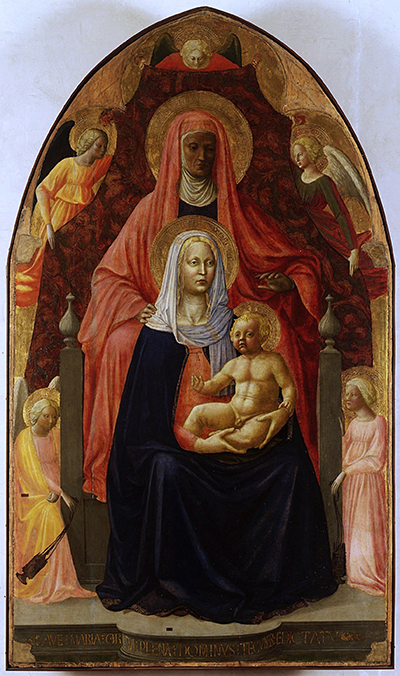The beautiful tempera on wood painting that depicts the Holy Mother, her child, and St. Anne illustrates the lush artistic feel of the artist, Masaccio.
The artist often showcased the Virgin Mother, and her Child Jesus in an array of his artwork as their natural presence held an innocent and loving emotion. These paintings often held a powerful volume behind them as they were praised by the technique, colour, and form used by the artist. A few of Masaccio's paintings that illustrate these sensual emotions include Maria and Child, Madonna of Humility, and Madonna Casini.
The artwork is one of the earliest works of Masaccio, dating back to roughly 1424-1425. The surface of the artwork is flattened into a two-dimensional form as the use of depth was no common at the time. This flattened artwork holds a gothic undertone to it, as the Renaissance Era is more promisingly known for its use of its use of shape within paintings.
Art critics to hold immense influence by MasaccioÕs contemporary Donatello credit the artwork. The soft rounding of the edges and the natural presence of the figures is a common characteristic used by Donatello within his artwork.
The Virgin Mary is seated on a throne in an upright position as her head is slightly tilted to the side. He glare stares off into the distance, as if she purposely ignored the presence of the viewer. Her emotionless face adds a prominent appeal as her sharp glare accentuates her power.
Within her arms, her only begotten son is seated staring off into the opposite direction of his mother. The young ruler is painted in a golden bronze colour, instead of the classic nudes that Masaccio will later use throughout his artwork. His blonde curly hair frames his face as a golden aurora surrounds the remaining background.
St. Anne stands upon Mother Mary and her child behind the throne. Her face is painted in a much darker shade of brown than the other two figures beneath her. Masaccio used this technique in order to illustrate her insignificant presence in comparison to the Virgin Madonna and future head of the religion.
St. Anne is dressed in a large peach coloured cloak that flows down her form. Even though the painting is one of the first works by Masaccio, it is evidently illustrated that the artist carried a gifted ability as he used long structured brush strokes in order to showcase the caverns and edges of the fabric. These long lines are used to illustrate how the fabric folds and falls upon St. Anne.
It is even evident within St. MaryÕs attire that Masaccio used a long brush stroke to showcase the texture of her velvet blue attire.
Behind the three figures, a burgundy fabric is held upwards covered in a swirling pattern of vines and flowers. A delicate touch was used to illustrate this cloak as the fine details swerve around the canvas. This burgundy fabric is held by three angels that fly within the air covering the background.
These magnificent beings are illustrated much smaller than the powerful three within the middle, yet add more interest within the painting. The angels are dressed in silky fabrics of light colours seized in orange, pink, and red. Of the five angels showcased, three have white wings, whereas the remaining angels have black wings.
The overall background of the painting is coloured in a deep bronze colour that highly resembles a few of Masaccio's future paintings. This ability to witness the power of colour through the emotion it evokes in a significant ability of the artist.




